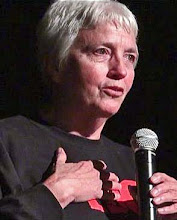
- Crawling though decrepit attics to find doubled-up families.
- Cutting taxes for the highest income bracket to stimulate the Kansas economy.
- Discovering that a stable, financially comfortable community has close to 50% of their students living in or near poverty.
- Realizing that the state's budget has gaping holes, so cut education funding across-the-board.
What a state I'm in, Kansas, where I'll be spending the bulk of my time in the next several weeks. My unplanned offer to film Worn Out Welcome Mat--KS, a short documentary on families doubled up because they have nowhere to go was accepted by the state coordinator of the homeless education program. What a tremendous opportunity! And the timing couldn't be better. It's like being dropped into an economic war zone.
Homeless families and youth have been, in many places across this state, hidden. Very few resources exist, especially away from metro areas, and even there it's a brutal struggle.
The KS Department of Education has made tremendous strides training and encouraging educators to identify and assist homeless students. Their census numbers have steadily climbed, not a good thing on one hand, but good that they're identifying and serving more, nearly triple since the recession.
- 2007 -- 3,569
- 2014 -- 10, 378
I've spent worthwhile chunks of time this past week with school officials, migrant assistance staff, community leaders and volunteers here in Manhattan, KS. Riley County, which includes Manhattan (The Little Apple) and surrounding area--rural and military--just completed a needs' assessment. Not surprisingly, they determined,
"Riley County is a community that is divided between a high quality of life, prosperity, and growth on one hand, and dwindling resources for and lack of attention to those who are most in need on the other."A brief conversation I had with someone who should know better (remaining unnamed for the time being), reinforced the importance of our WOWM film project--which will be comprised of kids and parents talking about the struggles of living doubled up because they have nowhere to go.
This person differentiated between those "literally homeless" and those "choosing" to live doubled up. The "literally homeless" term is HUD (US Dept. of Housing and Urban Development) language reflecting a limited definition of homelessness that excludes millions of homeless families and youth. I'll get back to this person.
I listened to the migrant assistance worker telling about crawling through the dark attic and finding a family living/cowering in the far reaches of this abandoned building's top level. Desperation and fear caused this homeless Kansas family to hide in the attic. At least these outreach workers were bringing help. How many more are living in these dire circumstances?
It's worth the reminder:
- No community has adequate emergency shelters for families/youth.
- Some communities have NO shelters, especially for youth (on their own without parent/guardian) or families.
- Some shelters turn families away because they don't accept intact families with older boys, two parent families, or parent/s with work schedules that conflict with curfews, or because a family member has a felony, mental illness, addiction problem, etc.
- Time limits, capacity issues, immigration status and requiring proof of homelessness can also be barriers for families seeking emergency shelter.
Right now my hope is resting heavily on the families and youth I'll be interviewing in the next several weeks. Their faces and stories will, I know, be powerful tools to open minds and hearts, raising awareness of the struggles of thousands of people--families, youth, and single adults-- in this state with nowhere to go.
Please consider helping HEAR US raise funds for this project. Yes, it's for Kansas, but they need the help--at least the homeless families/youth and those working hard to serve them. If we can make things work in KS, we can turn to the next state where gross neglect of impoverished families and youth is rampant. Plenty of choices.







